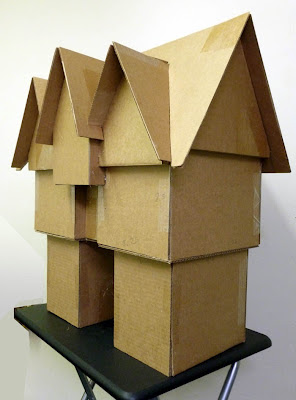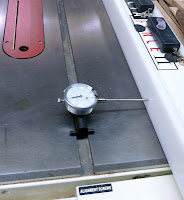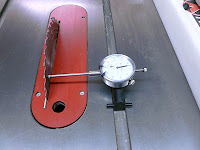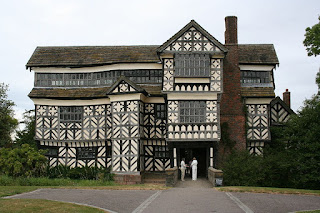April 30, 2012
Parisian Houses in 1610
An engraving showing a street in Paris in 1610. The subject is the assassination of Henri IV, king of France. Photo from
http://en.wikipedia.org/wiki/File:Assassination_of_Henry_IV_%28Henry_IV,_King_of_France;_Fran%C3%A7ois_Ravaillac%29_by_Gaspar_Bouttats.jpg
Are you surprised to see the Dutch influence on these houses in Paris?
The old houses such as these were all destroyed to make way for new buildings, part of the plans to create the most beautiful city in the world. Of course it was not done all in one fell swoop. A couple of Napoleons, war, fire and of course decay all played a part. Oh well and who is to say it was not well worth the results? It is certainly a more liveable and elegant city compared to having winding streets of crumbling buildings.
The Dutch style was also an influence on the brick houses of Elizabethan England in the same historic period.
Elizabethan Gatehouse Mockup
Front of house
Back of house
The cardboard model turned out very close to my vision. But looking at it I decided I will add a half inch to the height of the second story and trim a half an inch off the lower edge of twin dormers on the front. Those kind of subtle changes are why I take the time to mockup the project in cardboard, I can see these subtle things more clearly. It will be very easy to make those two changes in my CAD model. In the image below you can see where I am querying the CAD model for some of the dimensions I needed for cutting the cardboard parts.
Next I will try adding two fireplace chimneys to the roof of the cardboard model. Chimneys are a lot of work to make and they are also an issue in terms of holding up to weathering outdoors. Therefore I will have to decide if I feel they are absolutely essential or not. They are a significant design feature on Elizabethan buildings so I must try them to see if they contribute to the overall impact.
After that chimney decision is made I will start putting all the details into the CAD model, the doors, windows, trims, brackets, timbers, etc. This birdhouse is really going to be loaded with lots of architectural details and carvings.
Cutting board and tools
The second floor and attic dormers will have glass windows in them. Inside the structure I will add low voltage LED lighting to shine out them at night. So not only is this piece going to function as a birdhouse, it is also a lamp and of course first and foremost it is an outdoor sculpture.
It could also be a dollhouse as I have designed it in 1:12 scale but than was not what was requested and it would take a lot more time too.
April 28, 2012
Fine tuning for miniatures
The other day I noticed the throat plate on my 10 inch table saw was a bit wobbly, not all of the leveling screws were touching the supports underneath. I was cutting a length of wood that was shorter in length than the throat plate so it became a safety issue and of course also a quality issue. Time for a precision tuneup. I cut large lumber pieces into strip wood down to about an 1/8 inch or so on this saw so I need accuracy from it.
Not all tablesaw throat plates mount and level the way mine does so you will have to figure out the best way to level yours. But it is important to make sure it is flat and very close to level side to side and front to back.
The first thing I do to the throat plate is make sure it is flat. Then I take a file and flatten the ends of the adjusting screws. The ends of machine screws are typically rough with burrs around the outside edge left from the manufacturing process.
Leveling can be done with the use of a straight edge resting on the table top sliding it back and forth to see if it hits but that is a rather clumsy and hit or miss method, you can't really see how close you are to dead level. All you can tell is if you hit an edge. Better than nothing though and that is how I used to do it. Nowadays I use a dial indicator gauge mounted in a holder. This is not expensive, you can get the setup for around $20.00 but you do want to be sure you have an extension for the feeler end of the indicator so it reaches the table. Dial indicators are useful for other kinds of tool setups as well such as working on lathes, seeing drilling or overarm router depth and router bit heights in standard router tables.
http://www.grizzly.com/outlet/Magnetic-Base-Dial-Indicator-Combo-President-s-Special/G9849
I start by leveling each end at the center then check the level at each of the four screws, then back to double check the two ends. When finished all screws should be firmly resting on the support underneath with no rocking. On this big saw I leave the back end of the throat plate about half a thousandths high and the front end about that same amount low. That prevents the wood from potentially catching when I make my cuts.
For precise cuts like dadoes in miniature furniture or for cutting and tiny strip wood pieces or miniature furniture pieces then I use a 4 inch or 2 inch miniature table saw. Be sure you have level throat plates on these smaller saws. It is not a worry with the Preac or Jim Byrnes table saws as they are designed and made level (unless you bend one) but it can be an issue on Proxxon, Micromark and Dremel table saws.
Since I had out the tools I use to calibrate my saws, lathes and such I went ahead and checked to be sure my table saw blade was still square to the miter slot and that the saw fence was also in proper alignment. I am using the same dial indicator type but a different holder that fits into the miter slot. One of these days I need to make a miter slot fixture for my miniature table saws, no one sells that item.
Saw cuts, drilled holes, routed edges are only as good as your hand control for feeding them combined with the quality of your tools but also it also matters how you set tools up and care for them.
April 25, 2012
Elizabethan Era
The image above is of Little Moreton Hall from Wikipedia. This building is one of many Elizabethan structures that inspire me.
I have changed direction once again on the birdhouse I am making for my brother. There are a lot of half timbered buildings from the late 1500s and early 1600s that I find to be inspiring including the Stokesay Castle Gatehouse, one of my all time favorite buildings. Old hand drawn illustration of it below
 |
| Wikipedia Image common license |
But I don't want to try and replicate an existing building as much as I love the Stokesay Castle Gatehouse. I prefer to design my pieces "in the style of" an era rather than creating a scale model. For one thing I don't have direct access to old buildings here in Seattle unless I count the authentic Tudor Manor house that is near Tacoma, WA. It was taken apart and shipped to the USA then reassembled brick by brick. So this morning I got busy in my CAD program and began designing an Elizabethan Gatehouse to build in 1:12 scale. The basic size and shape of the building is now finished but not much in the way of fine details. That is how I work, first the massing study for overall impact and balance then later I start embellishing the surfaces with all the details.
No interior needs to be done as it is not a dollhouse. I will be putting my recently upgraded carving skills to good use on it! Tonight I will start cutting walls, first in cardboard, then the marine plywood I use for birdhouse substrates. I can't make any mistakes or redo the plywood pieces, too expensive and hard to come by that material in recent years. That is one reason I no longer make many birdhouses. Local shipbuilders have been on an almost year long waiting list for their materials.
My recent list of films to watch have included Shakespeare in Love, Anonymous and Elizabeth. A little bit of synthetic time travel, amusing as well if not completely authentic in details.
Elizabethan birdhouse
April 19, 2012
dragon of the day
 |
| photo copyright Karin Corbin 2012 |
I am using up some pieces of pear wood from the end of the slab where there are cracks from the wood drying. It makes good practice wood, the pieces are not too small, not too large.
The antiquing is done using a couple of colors of stain. The first coat is lighter in tone and the second coat is some old thick, dark walnut stain. Lighter stain first keeps the piece from absorbing too much of the dark. Rub it on, wipe some off, wipe more on, hit it with a heat gun, wipe more off and on, etc. It is a random kind of process, not carefully controlled or thought out but it is still effective.
April 17, 2012
There be dragons
April 12, 2012
make a stropping wheel
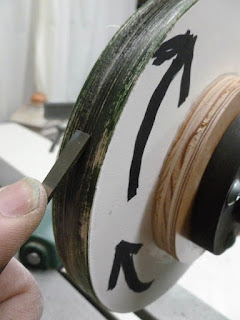 |
| photo copyright Karin Corbin 2012 |
The cost is low and the materials are easy to come by. The material the wheel is made from is mat board. Yes, it is the mat board you find at art supply stores and framing shops. You adhere layers of it together with a PVA glue such as Elmers. Be sure you cut accurate circles so you don't have to spend a lot of time shaping it into a true circular surface after you mount it to a motor. I did the final shaping of my wheel with a coarse grit sanding block while the motor was spinning the wheel. The sanding to a true circle creates a lot of fine dust so I used a vacuum cleaner nozzle right next to my sanding area to collect the dust. Don't forget to wear a dust mask! After the wheel is trued you can put honing compound on it.
I used 8 layers of double thick mat board in this wheel. I put weights on the stack of mat board disk while the glue set to prevent voids in the layers. Getting voids is a defect that will spoil the effectiveness of the wheel.
I have glued my new stropping wheel onto a plywood disk screwed to a faceplate so I could spin it with my lathe. It is very important to look at the photo above to see how the wheel should be turning in relationship to the tools you are sharpening. I am standing on the backside of my lathe while I am sharpening my carving tools to get the correct spin direction.
What a difference using this wheel is making in my work. I can't get my carving tools this sharp with hand stropping on leather. The tools now glide through the cuts with little effort or pressure leaving a nicely polished surface. I hear that lovely ssssstt noise as the tools cut. The noise that only happens when you have razor sharp cutting edges with polished bevels.
transfering images
 |
| photo copyright Karin Corbin 2012 |
Thin pencil leads break or else the lines keep getting wider as the pencil wears down. Also the paper the image is printed on can tear when drawing on it if you press firmly.
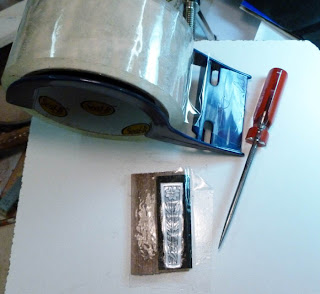 |
| photo copyright Karin Corbin 2012 |
So now I cut a small piece of carbon paper, cut the image to size and use clear cello packaging tape to hold those two items together covering complete over the paper leaving the tape wide enough to stick the image to the surface I am working on.
Instead of a pencil I use a metal scribe held at a slight angle so the point glides along on the surface of the packaging tape. Packaging tape is pretty tough stuff but it does remove without any trouble from the surface of the wood.
The end result is very nice image transfers with good dark lines and it is quickly done because there is no shifting or fussing.
April 11, 2012
practice, practice, practice
 |
| photo copyright Karin Corbin 2012 |
This pattern is really hard to cut because of all the curves, it frustrates me to do them because I can't get the big curves as even as I would like them to be. My hands are simply not yet fully trained for carving movements but day by day I am gaining on it.
This piece was from a piece of the free walnut wood I got the other week, nice and dark and the grain is OK, it carves nicely too. I think I will start making some trinket boxes out of the better practice pieces. One of these days I will have something good enough to use for furniture in my miniature cottage project. I need one or two chest, a table, dish cupboard, chairs, a bed, etc.
I have had to make a few more carving chisels, wish I had some more smaller gouges too. I had to switch out to my larger magnifying lamp and even the short pear handled gouges hit the lens. Always something to frustrate me while making miniatures...
April 4, 2012
tudor rose
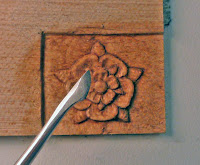 |
| photo copyright Karin Corbin 2012 |
In the photo above is a wax carving tool I modified to be similar to the shape of a Ray Gonzales Hooked Skew Chisel The shape of his skew chisel intrigued me and there are many good reviews about it. However it does not come in a size for carving small scale miniatures so I decided to give it a go to make one. After I modified the shape I took it to my neighborhood knife maker for a professional sharpening. The tool looks bigger than it is as it was much closer to the camera than the carving.
I really like this little tool, it does a great job of detailing in tight spaces. The curve keeps the tips from digging in when using it for background cutting. It can also be used as a scraper for smoothing out problem areas. The cutting edge is 7mm from tip to heel. I would like to have more of a hooked point at the heel but that will have to wait until I have my knife guy custom make me one from high carbon, high quality steel that will hold an edge for a long time.
Subscribe to:
Posts (Atom)

